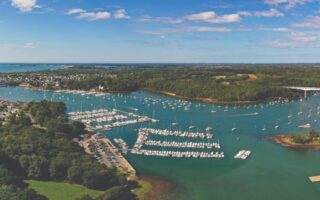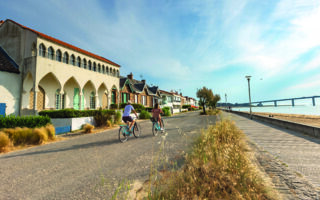Circulade Villages in the Languedoc

Discovering Mediaeval Architecture
If you are travelling around the Languedoc plain you will come across village built in a circular pattern. So, you might ask, why a circle?
There are paintings of circular towns dating back to Roman and Greek times, as the circle was considered the ideal form in those days. But was this merely a pictorial ideal?
Between the eleventh and twelfth centuries a whole series of circular villages emerged in this region, evidence of a planned architectural model. They only exist, moreover, in the southern part of France, and are thought to be the first example of urban development of the Middle Ages.
Early drawings from the nineteenth century demonstrate that the fortified centre of a village/town was represented by a circle. The villages are often centred around the church which is the highest point, although in later times the influence of the church sometimes gave way to the political force of the day, in which case the castle became the focal point.
The circular form provides an obvious means of protection against marauders. Roman arenas and amphitheatres were also circular or oval, and these would have influenced local construction. The circular model could also have been the influence of different invaders – there are examples of circular towns in Iraq and ancient Persia, including Baghdad. Islamic fortification was admired in France in the Middle Ages and would have been discovered during the time of the crusades.
These are some of the circulade villages which you can visit:
There are only a few in the Gard: Montpezat, Aigremont, La Calmette and Souvignargues.
In the Hérault there are:
- Le Pouget
- Puéchabon
- Saint Jean-de-Fos
- Saint-Pargoire
- Balaruc-le-Vieux
- Castries
- Poussan
In the region around Béziers there are many more.
Castries
Easily bypassed on the motorway, Castries (from castrum = guard post)deserves a visit to its beautiful mediaeval centre. The town served as a watch point in Roman days. From the outskirts of the town you can glimpse its Château with its three square towers topped by stunning pagoda-style red tiled roofs. The first castle is mentioned in the records of Elzéar Dalmas in the eleventh century, and has been greatly altered through the years into the present Renaissance style.
The fourth wing was partially destroyed in 1622 by the Duke of Rohan at the head of a protestant troop revolting against Louis XIII. The terrasses and park occupy 12 hectares but it is not possible to visit house or gardens. It was Paul Riquet, builder of the Canal du Midi, who at the request of the family of the Croix de Castries built an aqueduct in 1676 to feed water into the castle grounds. The Academie Française now owns the castle.
Attempt to find the castle gates for a shot of its roofs, and you will find yourself exploring lanes with houses buttressed to the castle wall. You can almost see the mediaeval villagers walking through muddy lanes: the houses appear untouched by time. In the surrounding area you can visit the aqueduct, an eighteenth century bridge, and the ruins of the command post of the Templars who were based here until the dissolution of the Order in 1307.
Source:
‘Circulades Languedociennes de l’antiquité’, by Krzysztof Pawlowksi
Visit also the tourist office at the entrance to Castries.
Share to: Facebook Twitter LinkedIn Email
More in canals, centre, family, garden, tourism, villages, walking
By FrenchEntrée
Leave a reply
Your email address will not be published. Required fields are marked *



